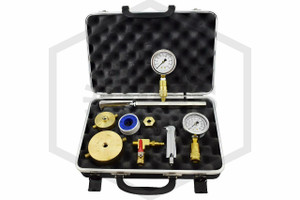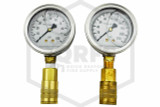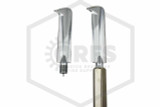11 Piece No. 1 Flow Test Kit
This No. 1 Flow Test Kit is designed and specifically curated for easy, convenient, and accurate water flow testing in water based and fire protection systems such as fire hydrants, hose, and other water-flowing equipment. This 11-piece kit includes:
- Two 1/4 in. NPT 2-1/2 in. Liquid Pressure Gauges (Gauge Range Options available -30-300 PSI)
- Three Brass Test Caps: One 3/4 in. Faucet Test Cap, One 1-1/2 in. Hose Test Cap One 2-1/2 in. Hydrant Test Cap
- One Quick-Disconnect Double-Ball Bleeder Valve
- One Hex Pitot Gauge Handle
- Two Standard Pitot Blades
- One 43-1/3 in. Roll of PTFE thread-seal tape
- One Plano Medium All-Weather Carrying Case – Plano is a world-famous manufacturer of hard-shell rugged outdoor cases.
Which dial ranges should I choose?
The gauges in this flow test kit is available in multiple dial ranges. To prolong your gauge’s life, choose a range that places your expected pressures at the center of the dial or in the mid-range. For example, for testing outlets with 30 PSI choose a 0-60 PSI gauge range or for testing outlets with 50 PSI choose a 100 PSI gauge range.
|
Dial Ranges |
Major Graduations |
Minor Graduations |
Smallest Graduations |
|
-30-0-300 PSI |
50 |
10 |
5 |
|
-30-0-200 PSI |
20 |
10 |
2 |
|
-30-0-100 PSI |
20 |
10 |
2 |
|
0-30 PSI |
5 |
1 |
5 |
|
0-60 PSI |
10 |
5 |
1 |
|
0-100 PSI |
10 |
10 |
1 |
|
0-160 PSI |
20 |
10 |
2 |
|
0-200 PSI |
20 |
10 |
2 |
|
0-300 PSI |
50 |
10 |
5 |
QRFS SKU: |
40-NW-801 |
Manufacturer Part Number: |
#801 |
Manufacturer: |
New England Manufacturing |
Application: |
Flow Test Kit 801 |
Model: |
No. 1 |
Gauges: |
2 x 1/4 in. NPT 2-1/2 in. Liquid Filled |
Gauge Range Options: |
Yes |
Gauge Range(s): |
-30-300 PSI |
NIST Certificate Available: |
No |
Brass Test Cap(s): |
One of Each: 3/4, 1-1/2, 2-1/2 in. |
Bleeder Valve: |
One Quick Disconnect Double-Ball |
Pitot Gauge Handle: |
One Hex Handle |
Pitot Blades: |
Two Standard Blades |
Hydrant Flow Nozzle: |
No |
Elbow: |
No |
Case Dimensions: |
16-1/2 in. x 13 in. x 6-3/4 in. |
PTFE Tape: |
Yes |
Spare Gaskets: |
No |
Total Pieces: |
11 |
Length: |
16.5 in. (419.1 mm) |
Width: |
13 in. (330.2 mm) |
Height: |
6.75 in. (171.45 mm) |
Weight: |
15 lb. (6.8 kg) |
Box/Pack Quantity: |
1 |
















